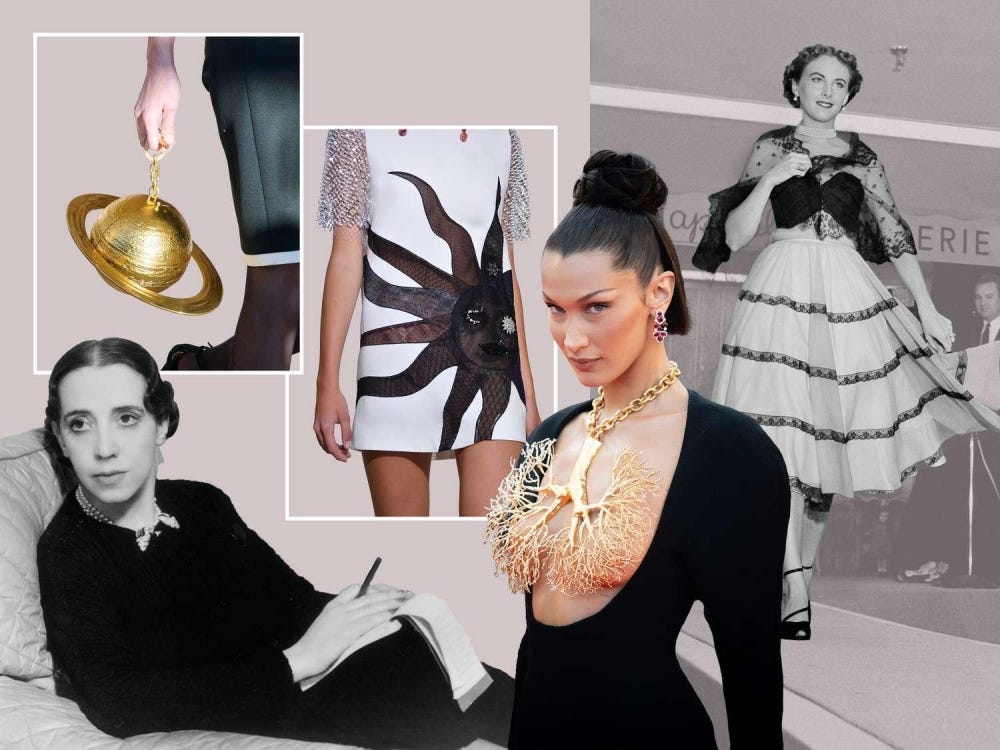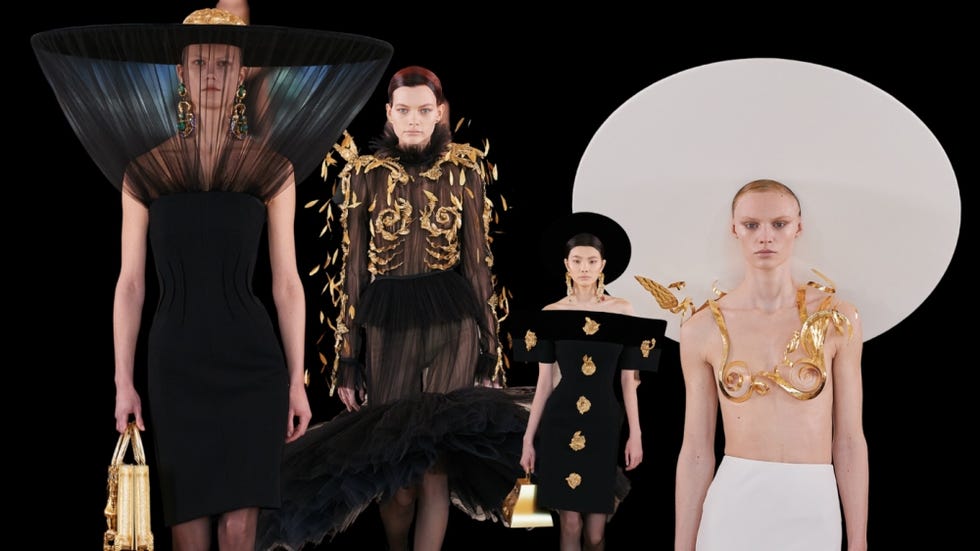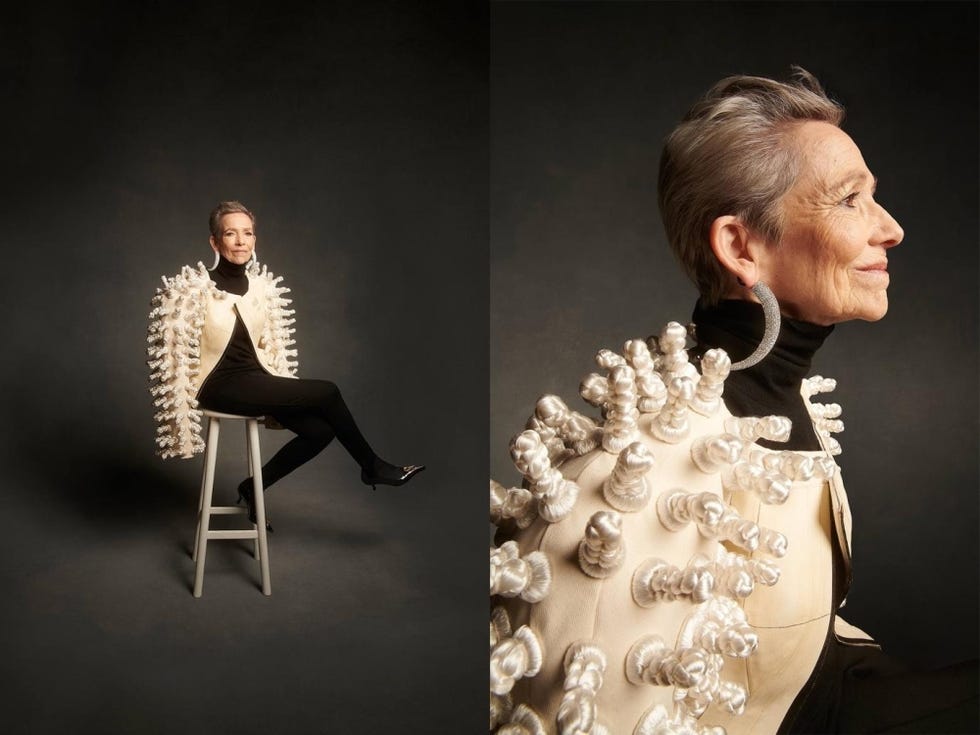When Schiaparelli’s founder, Elsa Schiaparelli, co-designed the famous lobster dress with Dalí in the 1930s, she probably never imagined that surrealism would one day be reborn in men’s closets. In a context where the boundaries of menswear are constantly being broken down and gender fluidity is increasingly becoming the new normal in fashion, if the brand, for which surrealism is a core aesthetic, were to venture into men’s wear, or more accurately: if Schiaparelli were to expand, its most interesting and likely direction might be men’s wear.
Schiaparelli has [Dadaism] and [Surrealism] naturally flowing in its DNA. Founded in 1927, the brand is known for its collaborations with pioneering artists such as Magritte and Man Ray, whose work is not [clothes] but [wearable art]. Under Roseberry’s leadership, the brand has re-embraced the absurd and the imaginative, from goddess-like anatomical structure earrings to metallic collarbone corsets, each season is a rendition of [fashion as art].

Why can’t this surreal, romantic and grotesque beauty be carried over to menswear? After all, while Harry Styles and Timothée Chalamet frequently wear feminine looks on the red carpet, the boundaries of men’s fashion have already been expanding, and Schiaparelli’s foray into men’s fashion is not a risk, but a return to a tradition that prides itself on breaking down the boundaries of gender and aesthetics. A tradition that prides itself on breaking gender and aesthetic boundaries.
The numbers don’t lie. According to Market Research Future, the global menswear market will grow from $610.7 billion in 2023 to $988.2 billion in 2032, a CAGR of 6.2%. At a time when traditional women’s fashion is becoming saturated, menswear has become a new growth engine for many luxury brands. From Dior Homme to Gucci Men, men are becoming more fashion savvy and more willing to spend money – more willing to pay for personalized design and brand stories.
Schiaparelli has strong brand equity and cultural depth. The key to the success of brand extension is that consumers have a strong cognitive and emotional connection to the original brand, and Schiaparelli is just such a [story-based] brand – its user group pays more attention to symbolic meaning and cultural value, rather than just practicality.

Imagine a menswear collection where rose gold chains define the shoulder line, the silhouette of a blouse pays homage to a 1930s suit, the buttons are micro-engraved brass eyes, and the hems of the pants are emblazoned with a surreal poem: Schiaparelli’s menswear is not simply [women’s clothes made larger], but a continuation of the brand’s aesthetics, combined with the desire of the contemporary man for style and identity to create a universe of power and fantasy. It will continue the brand’s aesthetics and combine contemporary men’s desire for style and identity expression to create a clothing universe compatible with power and fantasy.
The target consumers are 25-50 years old, well-educated, engaged in creative industries or high-end service industries, pursuing uniqueness, artistry and self-expression. They may be at a gallery opening reception on the Left Bank in Paris, or in a bookstore cafe in SoHo in New York, fixing a metallic black scarf in the mirror – a potential portrait of the Schiaparelli Men.
While Schiaparelli may have no intention of stepping into the menswear fray for now, all the clues – from market trends, to brand DNA, to cultural context – point to a clear future. If any brand can take menswear into a surreal dimension, it will be the same Schiaparelli that makes necklaces out of collarbones and defines haute couture in dreams.

The real opportunity for the brand lies not only in [entering menswear], but also in [redefining menswear]. In an era where mobility has become a keyword, menswear no longer means suits, ties, and neat tailoring in gray, blue, and black, but rather a medium that can hold emotions, identities, and even narratives. schiaparelli is already good at storytelling, and every piece of its design carries dramatic tension and symbolic language. Therefore, entering the menswear market is not a tonal risk for the brand, but an expansion of its own spiritual heritage.
What’s more, such menswear is not for everyone, but for those who [don’t rest on their laurels]: those who wish to express a worldview even while dressing, those who believe that clothing can be a religion. As Elsa Schiaparelli herself said, “In difficult times, fashion is always outrageous.” , perhaps today’s [outrageous] is precisely the crossing of gender boundaries towards a freer, more imaginative tomorrow.
SDCLI rPRd puUf FvQYUJu